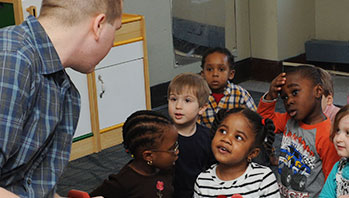- photographs or drawings of children’s plants from Weeks 1 and 2
- leaves
- root
- stem
MA Standards:
English Language Arts/Speaking and Listening/SL.PK.MA.1: Participate in collaborative conversations with diverse partners during daily routines and play.
English Language Arts/Language/L.PK.MA.1: Demonstrate use of oral language in informal everyday activities.
English Language Arts/Language/L.PK.MA.6: Use words and phrases acquired through conversations, listening to books read aloud, activities, and play.
Head Start Outcomes
Language Development/Receptive Language: Attends to language during conversations, songs, stories, or other learning experiences.
Language Development/Expressive Language: Uses language to express ideas and needs.
PreK Learning Guidelines:
English Language Arts/Language 2: Participate actively in discussions, listen to the ideas of others, and ask and answer relevant questions.
Talk Together: Parts of Plants

© Commonwealth of Massachusetts, Department of Early Education and Care (Jennifer Waddell photographer). All rights reserved.
STEM Key Concepts: Plants grow in many places; Plants have different parts: roots, stems, leaves, and fruit; Plants need water and sunlight to grow; Plants grow in places where they get their needs met; Plants often grow in some type of dirt; Plants exhibit diversity and variation; Some plant parts are below the ground and some above
ELA Focus Skills: Listening and Speaking, Vocabulary
Gather children in the area where they are growing their plants. Use the plants to review the parts of a plant with children. Show the plants (or photographs or children’s drawings if parts are not visible on the plants) and ask children to help you identify the roots, stems, and leaves of each plant. Give children the opportunity to tell what they know about each part of the plant. Ask if children have any new ideas they want to add to the “Plants All Around” chart.
Then tell children they are going to continue to observe plants and explore what new changes are happening to plants indoors and outdoors.
